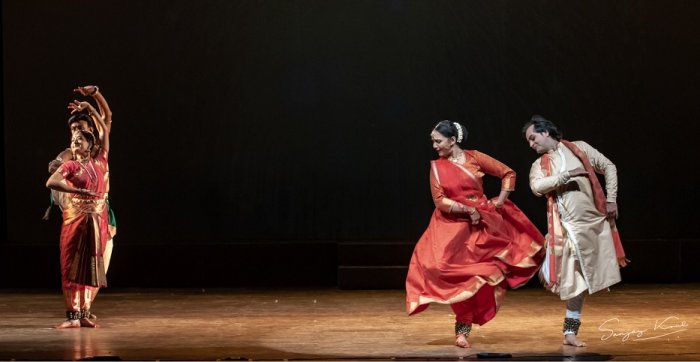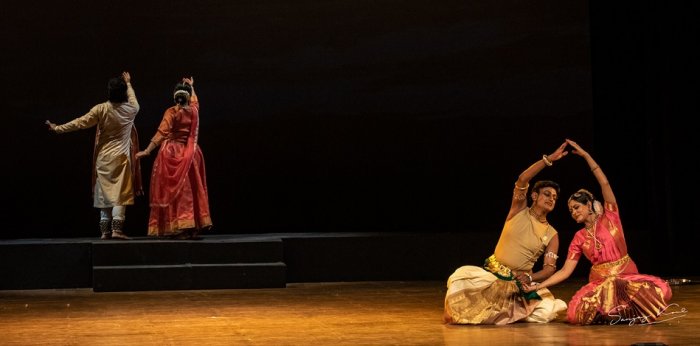
|   |

|   |
 e-mail: leelakaverivenkat@gmail.com Rango'ntaratma: Multi-media presentation with a difference April 17, 2019 Anugraham Classical Community, a charitable trust with a discerning membership presented Rango'ntaratma, a multi-media presentation conceived by Kamalini Dutt, ex-founder director of the Central Archives Doordarshan, where she pioneered the release of over 100 DVDs of intangible cultural heritage. The theme is inspired by Kashmir Shaivism in its non-dualistic approach (surprising when viewed against the backdrop of what is happening in Kashmir today) going back to that great son of Kashmir, Abhinavagupta, but for whose commentary, understanding of the Natya Sastra would have proved very difficult. Built round the central Sutra of Shiva Sutras concerning the inner consciousness as the performance arena where life is played out, this production tries to catch that unseen essence to be expressed through the language of music and dance. In a universe in constant motion the macro cosmos is reflected in every micro manifestation. Starting from the primordial Naada or sound, gradually awakening the primordial form, the Bindu, to its spread and interplay with Kaala or time which assumes myriad passing dimensions in Kalaa or art which has the ultimate purpose of evoking rasa or bliss (the ultimate state resembling brahmananda), is the journey, which Rango'ntaratma traces through two dance styles of Bharatanatyam and Kathak. Thinking, understanding and working out how this very abstract process could be meaningfully visualized through dance, has taken Kamalini Dutt over a year. While Kashmir Shaivism provides the inspiration, the production shows how these thoughts have travelled down the ages through other schools like southern Shaiva Siddhanta, not omitting contemporary poetry.  Photo: Sanjay Koul The performance at Delhi's Kamani with excellent installations in the lobby, started with Ranga puja with the entry of two dancers Purva Dhanashree and Dr. Sridhar Vasudevan presenting the Alarippu in Sankeerna ekam set and conducted by Ramamoorthi Sriganesh. On later inquiry if the rhythmic combination had any significance, Kamalini, whose choice it was, said that the harmony arrived at through an uneven combination of syllables, symbolized the inclusivity she was seeking amidst different unequal streams of philosophical persuasion comprising society. As a salutation to sacred space, the dancer through the abstract architecture of the Alarippu with its beautiful geometry of lines performed to mnemonics, bringing into play the angas, upangas and pratyangas (major and minor limbs of body invoking inner and outer space) in an obeisance to the space, to god, the audience and the guru. This abstract architecture of lines built on rhythm and movements set to mnemonics, can be compared to the outline of the temple tower (Gopuram screened as a background visual) within which space, a whole universe of faith plays out. The two experienced dancers combined beautifully. According to Shiva Sutra, seers experienced Shiva as Naada, the primordial selfborn sound from which all other shabda or sounds emanate (Naadaadeenam jagat sarvam). What better base could Purva Dhanashree's Bharatanatyam interpretation of Naada be built on than Tyagaraja's Kriti in ragam Chittaranjani expressing the very same thought, Naada tanumanisham Shankaram. Inspired by Vighyana Bhairava Tantra, 18h century Tyagaraja's composition invokes Shiva as Naada and essence of the Sama Veda. He describes the five faces of Shiva as Sadyojata, Vaamadeva, Aghora, Tatpurusha and Ishana out of which emanate the notes sa re ga ma pa dha ni to make music the power which could conquer even time or Kaala. To express through form 'soundless sound' (as Naada has been defined) calls for a highly internalized dance approach and both Purva's interpretation and the quality of silence with clear diction in the singing by Venkateshwaran Kuppuswamy made the right combination. Bindu, the Shakti awakened by Naada, is the activating creative energy, though Shiva and Shakti are not separate entities, but one (abheda). If Shakti is the energy, the energy holder is Shiva. To the shloka Amrutaarnava Madhyodyat set to raga Amritavarshini and Pum Rupam in Purvikalyani, Purva Dhanashree and Sridhar Vasudevan captured a feel of the two forces of Shiva and Shakti dancing on the Mulaadhaara chakra. Going round dancing back to back to prove the oneness was a wonderful moment. Thanks to Kashmir Shaivism, Kundalini Tantra attracted Adi Shankaracharya, who gave poetic expression to his philosophy in his Soundarya Lahari, the first phase of which is called the Anandalahari. Of the two paths of Shakti worship, Kaula Marga and Samayacharya, the latter which treats the sadhaka's body as Sri Chakra has been preferred by southern peethas of Shankaracharya, as at Sringeri Mutt and Kamakoti Peetha for example. Devotees flock to Kamalaamba and Tyagesha temple in Tiruvarur to experience Shiva/Shakti aikyam (undifferentiated Parameshwara and Parashakti). Music sung in a spirit of total surrender is believed to have the power of invoking the chakras removing the nine veils to reveal the Bindu deep within every being, and Sri Chakra Upasana and Sri Vidya are significant practices pertaining to Shaivite worship in the South.   Photos: Sanjay Koul From Soundarya Lahari, the verse Tavaadhaare Moole sung in Mohanam retained the beauty of the Shikharini Chhanda. Following this, Sridhar Vasudevan's projection based on Muthuswamy Dikshitar's Navavarna Kriti on Kamalaamba, Kanakaambari kaarunyamruta Lahari in raga Kanakaambari replete with tantric imagery was undoubtedly the highlight of the entire enterprise. For Vasudevan, who carried the entire audience with him on this journey as a sadhak, this journey was a meditative process touching an entirely different level of consciousness. Absorbed in body and mind, the part of the coiled energy spiraling like a snake, as energy cycles or chakras get activated one by one, till the final awakening of the Kundalini was an experience, awesome in its nature, giving the audience goose pimples. Even the jathi composed by percussionist Manohar Balachandirane, using "3 pentagons, 3 septagons, and 3 nonagons as a geometric representation" was based on the mandala motif trailokyamohanachakra, symbolizing the Kundalini coiled like a serpent rises, and the Bija mantras, not spoken were meditated upon with the sound hm. This was the individual's inner landscape being revealed and had little to do with art expertise, which of course provided Sridhar with the language. For this critic, just this one experience made the evening special.
The concluding part of Rasa, the purpose of life according to Abhinavagupta, had natya through sringar through Adi Shankaracharya's "Shive Sringaaraadraa," the 51st shloka from Soundarya Lahari sung in Maru Behag set to addha taal, with Divya as Shakti reacting in different moods to all she saw on Shiva's person - in a leela or playful enactment, for both are one. Here again, a yogic detachment is called for, the dancer's involved evoking of various feelings with awareness, keeping his own identity separate. Kathak dancer Hemanth Kumar Kalita, made a very short appearance, dancing on Kamalini Dutt's Ragamalika in addha 'Yog ki chaadar' based on Mahopadesha Vimshatikam of Abhinavagupta followed by Bhairava Stavam of Abhinavagupta's "Vyaapta Charaachara Bhaava Vishesham" experiencing Maharasa abhinaya when the devotee asks, "If you are I and I am you, there is no I and you - who will bow to whom?" Bhairava Stavam of Abhinavagupta sees no dualism and the philosophy of abheda in the undifferentiated presence of Anandabhairava and Anandabhairavi where the sense of oneness goes beyond gender, was celebrated through the poetry of Suryakant Tripathi Nirala in Hindi (Tum tunga Himaalaya) and of Subramania Bharati in Tamil (Paayum Oli) which saw two couples dancing - one in Bharatanatyam and the other in Kathak taking the stage simultaneously. For some, the oneness was lacking with the two remaining separate. But I felt that the idea of the entire exercise was of underlying oneness amidst the play of seeming differences! For a brief moment in the Tillana in Bindumalini composed by Rakesh Pathak and Dr. Sridhar Vasudevan, all four dancers joined together forming one unified formation. But one felt that the last twenty minutes failed to hold the audience attention and seemed to drag needlessly. One can argue that this was not a 'performance' in the usual sense as much as throwing light on a philosophic concept inspired from the past to the present. The extraordinary Tantric paintings as visuals like the Svacchananda Bhairava Siva in Cosmic Linga, Sunil Raina Rajanaka's painting of the spot in Dachigam (where Shiva Sutras were believed to have been revealed) and several drawings added a special dimension to the entire presentation. A marathon effort altogether and can surely keep on evolving over repeated presentations.  Writing on the dance scene for the last forty years, Leela Venkataraman's incisive comments on performances of all dance forms, participation in dance discussions both in India and abroad, and as a regular contributor to Hindu Friday Review, journals like Sruti and Nartanam, makes her voice respected for its balanced critiquing. She is the author of several books like Indian Classical dance: Tradition in Transition, Classical Dance in India and Indian Classical dance: The Renaissance and Beyond. Post your comments Please provide your name and email id when you use the Anonymous profile in the blog to post a comment. All appropriate comments posted with name & email id in the blog will also be featured in the site. |